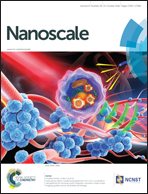A 3D co-culture microtissue model of the human placenta for nanotoxicity assessment†
Abstract
There is increasing evidence that certain nanoparticles (NPs) can overcome the placental barrier, raising concerns on potential adverse effects on the growing fetus. But even in the absence of placental transfer, NPs may pose a risk to proper fetal development if they interfere with the viability and functionality of the placental tissue. The effects of NPs on the human placenta are not well studied or understood, and predictive in vitro placenta models to achieve mechanistic insights on NP-placenta interactions are essentially lacking. Using the scaffold-free hanging drop technology, we developed a well-organized and highly reproducible 3D co-culture microtissue (MT) model consisting of a core of placental fibroblasts surrounded by a trophoblast cell layer, which resembles the structure of the in vivo placental tissue. We could show that secretion levels of human chorionic gonadotropin (hCG) were significantly higher in 3D than in 2D cell cultures, which indicates an enhanced differentiation of trophoblasts grown on 3D MTs. NP toxicity assessment revealed that cadmium telluride (CdTe) and copper oxide (CuO) NPs but not titanium dioxide (TiO2) NPs decreased MT viability and reduced the release of hCG. NP acute toxicity was significantly reduced in 3D co-culture MTs compared to 2D monocultures. Taken together, 3D placental MTs provide a new and promising model for the fast generation of tissue-relevant acute NP toxicity data, which are indispensable for the safe development of NPs for industrial, commercial and medical applications.


 Please wait while we load your content...
Please wait while we load your content...